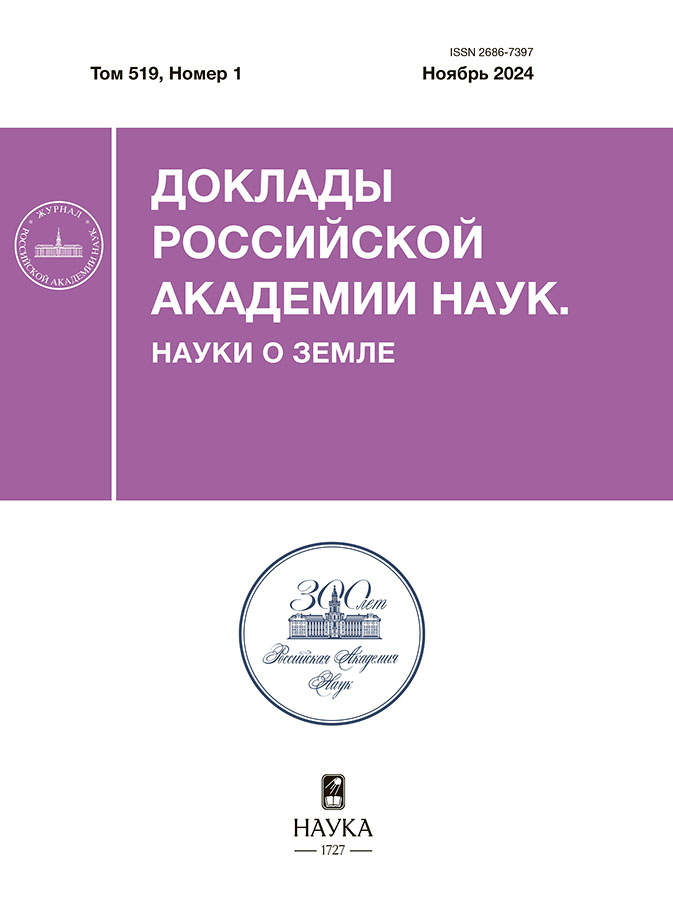Early pleistocene vegetation and environments near taurida cave (central crimea) on the basis of microphytofossil data
- 作者: Lopatina D.A.1, Zanina O.G.2, Lopatin A.V.3
-
隶属关系:
- Geological Institute, Russian Academy of Sciences
- Institute of Physicochemical and Biological Problems in Soil Science, Russian Academy of Sciences
- Borissiak Paleontological Institute, Russian Academy of Sciences
- 期: 卷 519, 编号 1 (2024)
- 页面: 509-516
- 栏目: PALEONTOLOGY
- ##submission.dateSubmitted##: 04.06.2025
- ##submission.datePublished##: 20.12.2024
- URL: https://snv63.ru/2686-7397/article/view/682436
- DOI: https://doi.org/10.31857/S2686739724110145
- ID: 682436
如何引用文章
详细
The existence of vegetation of open environments with a predominance of grass-forbs meadow associations and the participation of pine-oak forests was reconstructed on the basis of the study of microphytofossils from the Lower Pleistocene deposits of the Taurida cave in central Crimea. These results are consistent with data on the composition of land vertebrates from the Taurida locality. The studied spectrum demonstrates similarity with the spore-pollen assemblage of the Berezan horizon of Ukraine with a maximum age of about 1.8 Ma. Based on the abundance of trichomes and plant fibers similar to those of Ficus carica Linnaeus, 1753 in the coprolites, it is assumed that the extinct hyenas Pachycrocuta brevirostris (Gervais, 1850) ate fig fruits in certain seasons.
全文:
作者简介
D. Lopatina
Geological Institute, Russian Academy of Sciences
编辑信件的主要联系方式.
Email: dalopat@mail.ru
俄罗斯联邦, Moscow
O. Zanina
Institute of Physicochemical and Biological Problems in Soil Science, Russian Academy of Sciences
Email: dalopat@mail.ru
Academician of the RAS
俄罗斯联邦, Pushchino, Moscow OblastA. Lopatin
Borissiak Paleontological Institute, Russian Academy of Sciences
Email: dalopat@mail.ru
俄罗斯联邦, Moscow
参考
- Лопатин А.В., Вислобокова И.А., Лавров А.В. и др. Пещера Таврида – новое местонахождение раннеплейстоценовых позвоночных в Крыму // ДАН. 2019. Т. 485. № 3. С. 381–385.
- Лопатин А.В., Тесаков А.С. Раннеплейстоценовая белозубка Crocidura kornfeldi (Lipotyphla, Soricidae) из Крыма // Доклады Российской академии наук. Науки о жизни. 2021. Т. 501. № 1. С. 499–504.
- Хантемиров Д.Р., Гимранов Д.О., Лавров А.В. Результаты исследования копролитов гигантской короткомордой гиены Pachycrocuta brevirostris (Gervais, 1850) (пещера Таврида, Крым) // Экология: факты, гипотезы, модели. Материалы Всероссийской конференции молодых ученых. Екатеринбург, 18–22 апреля 2022 г. Екатеринбург, 2022. C. 145–150.
- Пыльцевой анализ / Ред. А.Н. Криштофович. М.: Госгеолиздат, 1950.
- Neumann K., Strömberg C.A.E., Ball T., et al. International Code for Phytolith Nomenclature (ICPN) 2.0 // Annals of Botany. 2019. № 124. P. 189–199.
- Scott L., Fernández-Jalvo Y., Carrión J., Brink J. Preservation and interpretation of pollen in hyaena coprolites: taphonomic observations from Spain and southern Africa // Palaeontologia Africana. 2003. V. 39. P. 83–91.
- Gatta M., Sinopoli G., Giardini M., et al. Pollen from Late Pleistocene hyena (Crocuta crocuta spelaea) coprolites: an interdisciplinary approach from two Italian sites // Review of Palaeobotany and Palynology. 2016. V. 233. P. 56–66.
- Scott L. Pollen analysis of hyena coprolites and sediments from Equus Cave, Taung, Southern Kalahari (South Africa) // Quaternary Research. 1987. V. 28. P. 144–156.
- Carrion J.S., Riquelme J.A., Navarro C., Munuera M. Pollen in hyaena coprolites reflects late glacial landscape in southern Spain // Palaeogeography, Palaeoclimatology, Palaeoecology. 2001. V. 176. P. 193–205.
- Сиренко Е.А. Палиностратиграфия континентальных верхнеплиоценовых – нижненеоплейстоценовых отложений южной части Восточно-Европейской платформы. Киев: Наукова думка, 2017.
- Pierantoni M., Tenne R., Rephael B., et al. Mineral deposits in Ficus leaves: morphologies and locations in relation to function // Plant Physiology. 2018. V. 176. № 2. P. 1751–1763.
- Giordano C., Maleci L., Agati G., Petruccelli R. Ficus carica L. leaf anatomy: trichomes and solid inclusions // Annals of Applied Biology. 2020. V. 176. № 1. P. 47–54.
- Minčo A., Goranova V. Trichome morphology of eleven genera of the tribe Alysseae (Brassicaceae) occurring in Bulgaria // Willdenowia. 2006. V. 36. № 1. P. 193–204.
- Cecchi L. A reappraisal of Phyllolepidum (Brassicaceae), a neglected genus of the European flora, and its relationships in tribe Alysseae // Plant Biosystems. 2011. V. 145. № 4. P. 818–831.
- Bülbül A., Varlic K., Armağan M. Taxonomic implication of trichomes on silicules in Alyssum L. (Brassicaceae) species in Turkey // Fresenius Environmental Bulletin. 2018. V. 27. № 12B. P. 9581–9589.
- Ilyinska A., Ryff L., Yevseyenkov P., Svirin S. Alyssum smyrnaeum (Brassicaceae): new records for the Crimean flora // Phytologia Balcanica. 2021. V. 27. № 1. P. 59–69.
- Зеленков Н.В. Ископаемый каменный огарь (Tadorna petrina) и широконоска (Spatula praeclypeata sp. nov.) – древнейшие раннеплейстоценовые утиные (Aves: Anatidae) Крыма // Палеонтологический журнал. 2022. № 6. С. 92–104.
- Mills M.G.L., Mills M.E.J. The diet of the brown hyaena Hyaena brunnea in the southern Kalahari // Koedoe. 1978. V. 21. P. 125–149.
- Holekamp K.E., Kolowski J.M. Family Hyaenidae (hyaenas) / In: Wilson D.E., Mittermeier R.A., eds. Handbook of the mammals of the World. V. 1. Carnivores. Barcelona: Lynx Edicions, 2009. P. 234–261.
- Alam M.S., Khan J.A. Food habits of striped hyena (Hyaena hyaena) in a semi-arid conservation area of India // Journal of Arid Land. 2015. V. 7. P. 860–866.
补充文件












